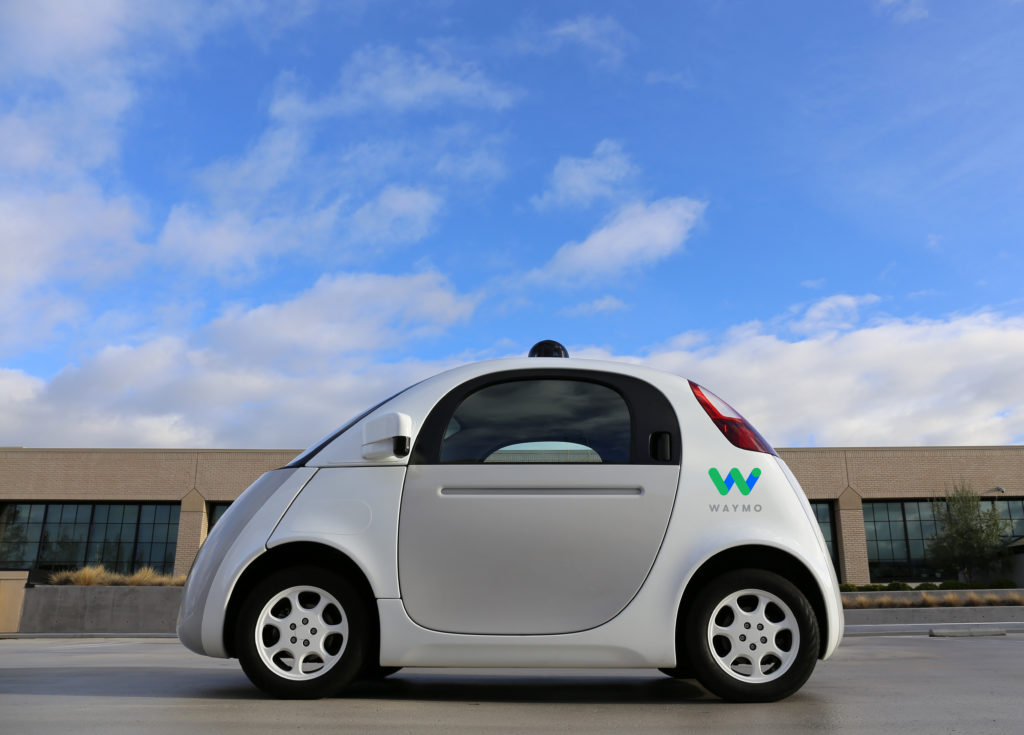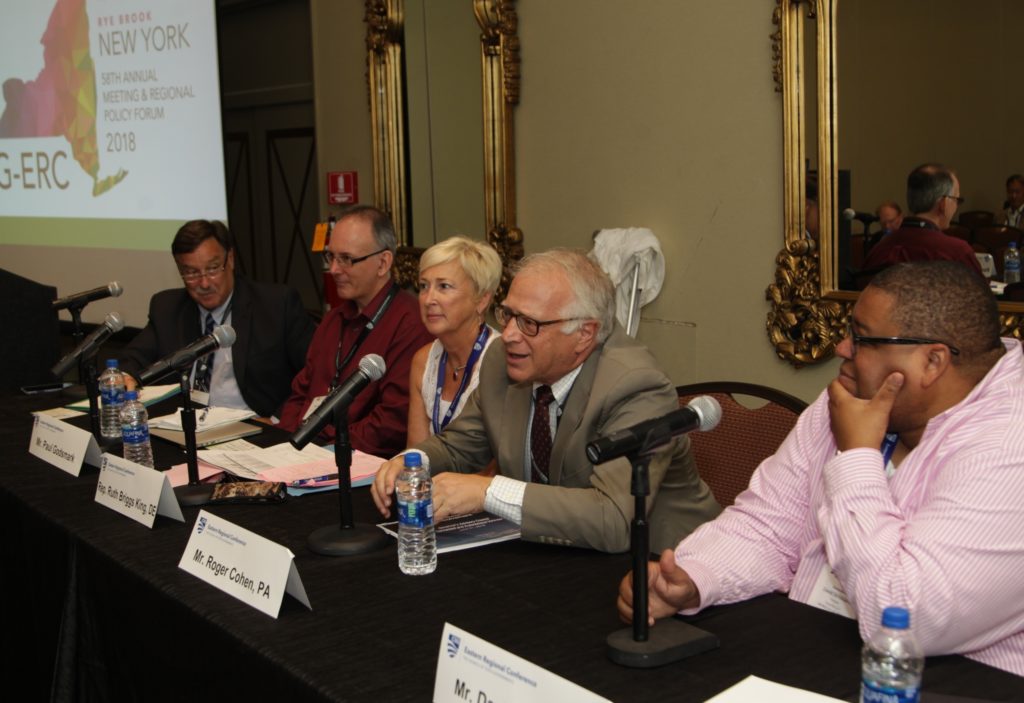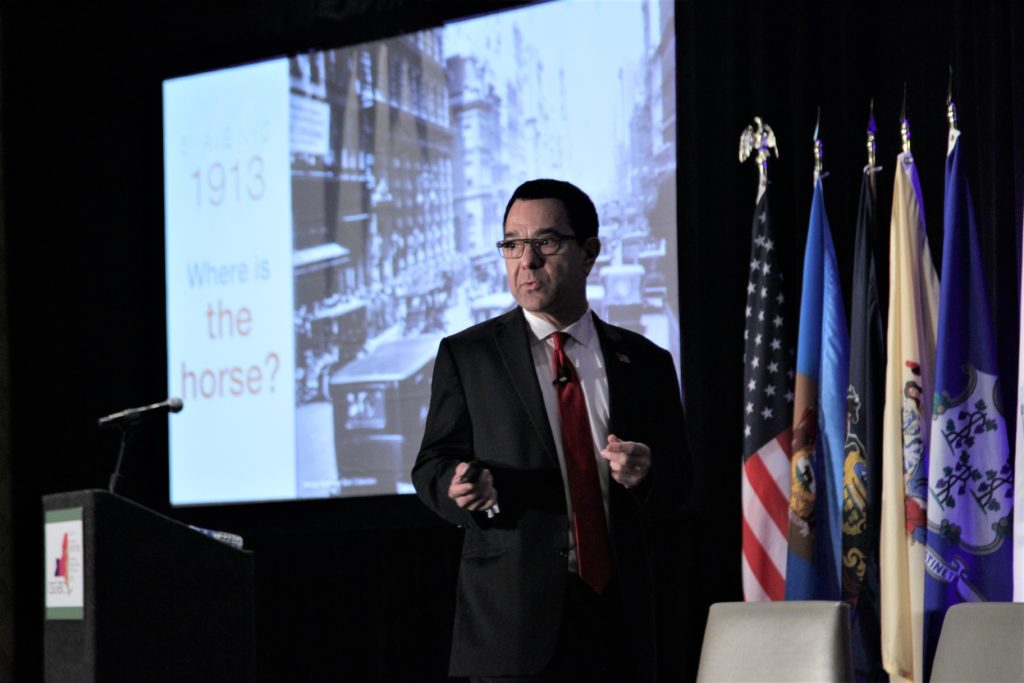Preparing for a transportation disruption
This article appeared in the 2018-19 edition of CSG East’s Perspectives Magazine.

Photo courtesy of Waymo
In a crowded conference room during the opening plenary of CSG East’s 2018 Annual Meeting, Stanford University instructor Tony Seba presented a photo of Fifth Avenue in New York City in 1910, teeming with horse-drawn carriages surrounding a solitary gasoline-powered automobile, the new technology of the day. The next photo, taken 13 years later, showed the situation in reverse: amid a sea of cars, there was a lone horse and buggy, soon to be rendered obsolete.
Seba calls the shift from carriages to the internal combustion engine a technology “disruption,” and he believes that society is headed for another one. His prediction: In a little over 10 years, most vehicles will be autonomous and powered by batteries, oil prices will collapse, and there will be a plunge in vehicle ownership as ride-hailing services become more affordable than owning a car.
“The 2020s will be the most disrupted decade in history, bar none,” said Seba, who is co-founder of ReThinkX and author of the book Clean Disruption of Energy and Transportation. “This disruption is going to happen really, really quickly. By 2030 it’s over,” he said. “And we’re on the cusp of that about to happen.”
In Seba’s view, disruption occurs when an innovative product or service creates a new market that significantly weakens, alters, or destroys an existing product or industry. Recent examples include the rise of digital imaging and the decline of film, as well as the emergence of the smartphone, which transformed personal communication.
These disruptions also created losers: the companies who failed to grasp how rapidly advancing technology and plummeting costs would render them obsolete, and their employees, whose jobs disappeared.
While it is impossible to predict with certainty what the future holds for autonomous or “driverless” vehicles, it is no secret that Google, Uber, and every major automaker are investing heavily in radar, lidar (similar to radar but using laser light), and other technologies that enable vehicles to sense their environment and navigate roads without human input. The industry is also developing connected vehicle technology that can read traffic signs, identify bicyclists’ hand signals, and sense pedestrians, among other features.
Government has had little role in promoting these technologies, but policymakers are increasingly aware that how the technology is implemented and its impact on society will hinge on their planning efforts. The federal government has not issued mandatory safety standards around the testing and use of autonomous vehicles, so a number of states have formed multistakeholder efforts to stay abreast of their development. They are exploring issues beyond the impacts to infrastructure — including concerns about safety, privacy, and liability. And they are raising questions about scenarios for which there is no precedent. For example, as vehicles are equipped with two-way communication capabilities, who is controlling the data and what are they doing with it? If an autonomous vehicle gets into an accident, is the passenger responsible?
“I think the technology will be ready before we have adequate laws, and on the East Coast I think we’re going to have to have coordinated planning from state to state. That’s why we need to do testing and have feedback,” said Delaware state Representative Ruth Briggs King.
CSG East’s Efforts on Autonomous Vehicles
Briggs King first explored issues around autonomous vehicles during a CSG East Transportation Committee seminar at the University of Pennsylvania’s Fels Institute of Government in 2017. There, she met industry experts; learned about different approaches underway in California, Michigan, and Arizona to test autonomous vehicles on roadways and establish guidelines for their use; and explored some of the complex policy questions that have emerged around safety and privacy. Twenty-nine states have enacted legislation related to autonomous vehicle technology, including establishment of study committees and authorization of the use of funds to incorporate two-way infrastructure-to-vehicle communication systems in transportation networks.

Delaware State Representative Ruth Briggs King (center) participating in a panel discussion on autonomous vehicles during the 2018 CSG East Annual Meeting. Also pictured, from left: Vermont State Representative Patrick Brennan; Paul Godsmark, Chief Technology Officer, Canadian Automated Vehicles Centre of Excellence; Roger Cohen, Senior Advisor to the Secretary, Pennsylvania State Department of Transportation; and David Strickland, Former Administrator, National Highway Traffic Safety Administration. Credit: Sebastian Marquez Velez
When Briggs King returned to Delaware, she filed a bill calling for the creation of a task force. The bill caught the interest of Gov. John Carney, who issued an executive order in fall 2017 creating an advisory council on connected and autonomous vehicles to assess their safe manufacturing, testing, and deployment. The council included stakeholders from different industries and levels of government that will be affected by the introduction of self-driving cars, including car dealerships, insurance companies, and city planners.
Participants formed subcommittees that explored opportunities to promote economic development, minimize job losses, prioritize safety, address issues around data privacy and cybersecurity, and ensure adequate revenue for the upkeep of the transportation system. In a society dominated by autonomous vehicles and widespread ride-hailing, policymakers will need to find alternative sources of revenue to replace gas taxes, speeding tickets, and parking garages.
Briggs King said that Seba’s discussion of how quickly the internal combustion engine replaced the horse and buggy should serve as a cautionary tale to policymakers to prepare for rapid changes ahead. “Technology has exploded and is moving much faster than our ability to integrate it well,” she said.
Technology and Business Convergence
Seba said smart people in mainstream organizations often overlook impending disruptions because they fail to analyze technology cost curves, like Moore’s law, which says that every two years, a consumer can purchase twice the computing power for the same dollar.
What enables big disruptions is not just the pace of technological change but also the convergence of different technologies and business models that can lower costs to enable functions that were not possible before, said Seba.
“Why did Google and Apple come out with the smartphone in 2007? That was the year that the technologies that made the creation of the smartphone converged,” said Seba. He cited the ability to combine computing, digital imaging, touch-screen technology, and lithium ion batteries in a single product at an affordable price.
In Seba’s theory, the current convergence propelling the transportation revolution involves rapid advances in autonomous vehicle and battery technologies, plunging costs, and the popularity of ride-hailing companies. In less than 10 years after its founding, Uber had more bookings than the entire taxi industry in America, he said. Seba calculates that electric, self-driving vehicles of the future will be 10 times cheaper to operate, so most people will stop driving and opt for ride-sharing, saving the typical household an average of $6,000 per year.

Stanford University instructor Tony Seba, author of the book Clean Disruption of Energy and Transportation, speaking during the 2018 CSG East Annual Meeting. Credit: Sebastian Marquez Velez
In the New York City metropolitan area, planners are already anticipating this shift. A report released in October 2017 by the Regional Plan Association, a research and advocacy organization in the New York City metropolitan area, forecast that autonomous vehicles will lead to a boom in the use of on-demand ride-sharing companies by lowering their costs. The report also warns of possible downsides, such as the loss of jobs for drivers and the potential for increased suburban sprawl and traffic congestion if the use of autonomous vehicles is not properly managed and takes riders away from public transit.
“AVs [autonomous vehicles] offer both great promise and peril depending upon how the technology is applied. What is clear, based on lessons learned from recent experiences from government with new ‘disruptive’ technologies is that the time to act is now,” the report says.
Preparing for an Electrified, Autonomous Future
Some industry sources question Seba’s ambitious timeline, pointing out that currently, electric vehicles make up around 1 percent of the vehicle fleet in the United States and globally and that self-driving vehicles are still in the testing stage. But few doubt that electrification and automation will figure prominently in the future of mobility, given the pace of investment that is underway.
Last year, the global electric vehicle stock grew by 57 percent, according to the International Energy Agency. Volvo has announced that starting in 2020, all of its new cars will be electric or hybrids. Manufacturers including Ford, Honda, GM, and Toyota have collectively invested billions of dollars in artificial intelligence and robotics technology. Recently, Toyota announced a $500 million investment in Uber, and GM has invested $500 million in Lyft to develop an integrated network of on-demand, self-driving cars.
Briggs King said Delaware is in a unique position to ensure that its infrastructure is prepared for the impending changes. The state owns 90 percent of its roadways and has already invested in sensors and other infrastructure needed to support connected autonomous vehicles. The University of Delaware has been testing the vehicles on its STAR (Science, Technology and Advanced Research) campus. The state is also operating a pilot program to explore the feasibility of implementing a mileage user tax as an alternative to gas taxes.
In a report released in September, the governor’s task force recommended that state transportation officials continue to invest in infrastructure to support connectivity on roadways, and officials approved funding in the state budget for rural broadband expansion that can reach beyond major roads. The report also suggested collaborating with neighboring states to remove regulatory hurdles and encouraging greater investment in autonomous vehicle infrastructure.
CSG East’s Transportation Committee has been actively involved in supporting collaborative efforts throughout the region. During the past three years, the committee has held discussions with state, territorial, and Canadian provincial leaders and well-recognized industry experts on critical issues relating to autonomous vehicles. Earlier this year, CSG East transportation policy consultant Don Hannon made a presentation to the Delaware task force on legislative and executive branch actions on autonomous vehicles across the nation.
Briggs King said that last September, she attended CSG’s Toll Fellowship program in Lexington, Kentucky, where she met with transportation leaders from around the country and discussed how they were moving forward. CSG East staff also informed her about model legislation introduced in other states. That information will prove helpful to her work on the governor’s task force, which will continue to meet on a quarterly basis going forward.
“I feel that we are moving in the right direction, and for me a lot of that started at CSG East’s conference in Philadelphia,” said Briggs King.